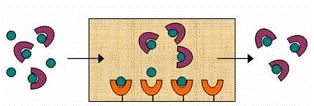Chemistry, Department of: Faculty Series

David Hage Publications
Document Type
Article
Date of this Version
4-17-2009
Citation
Published in final edited form as: J Chromatogr A. 2009 April 17; 1216(16): 3492–3500. doi:10.1016/j.chroma.2008.09.080. Version presented here is from NIH PubMed Central.
Abstract
Warfarin is often used as a site-specific probe for examining the binding of drugs and other solutes to Sudlow site I of human serum albumin (HSA). However, warfarin has strong binding to HSA and the two chiral forms of warfarin have slightly different binding affinities for this protein. Warfarin also undergoes a slow change in structure when present in common buffers used for binding studies. This report examined the use of four related, achiral compounds (i.e., coumarin, 7-hydroxycoumarin, 7-hydroxy-4-methylcoumarin, and 4-hydroxycoumarin) as possible alternative probes for Sudlow site I in drug binding studies. High-performance affinity chromatography and immobilized HSA columns were used to compare and evaluate the binding properties of these probe candidates. Binding for each of the tested probe candidates to HSA was found to give a good fit to a two-site model. The first group of sites had moderate-to-high affinities for the probe candidates with association equilibrium constants that ranged from 6.4 × 103 M−1 (coumarin) to 5.5 × 104 M−1 (4- hydroxycoumarin) at pH 7.4 and 37°C. The second group of weaker, and probably non-specific, binding regions, had association equilibrium constants that ranged from 3.8 × 101 M−1 (7-hydroxy-4- methylcoumarin) to 7.3 × 102 M−1 (coumarin). Competition experiments based on zonal elution indicated that all of these probe candidates competed with warfarin at their high affinity regions. Warfarin also showed competition with coumarin, 7-hydroxycoumarin and 7-hydroxy-4- methycoumarin for their weak affinity sites but appeared to not bind and or compete for all of the weak sites of 4-hydroxycoumarin. It was found from this group that 4-hydroxycoumarin was the best alternative to warfarin for examining the interactions of drugs at Sudlow site I on HSA. These results also provided information on how the major structural components of warfarin contribute to the binding of this drug at Sudlow site I.


Comments
Copyright Elsevier Inc. Used By Permission.